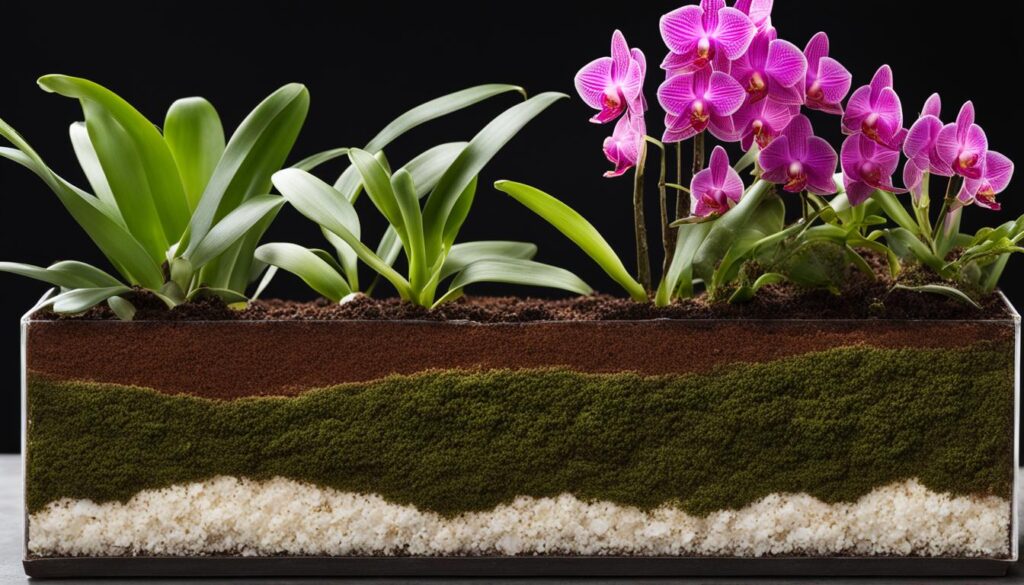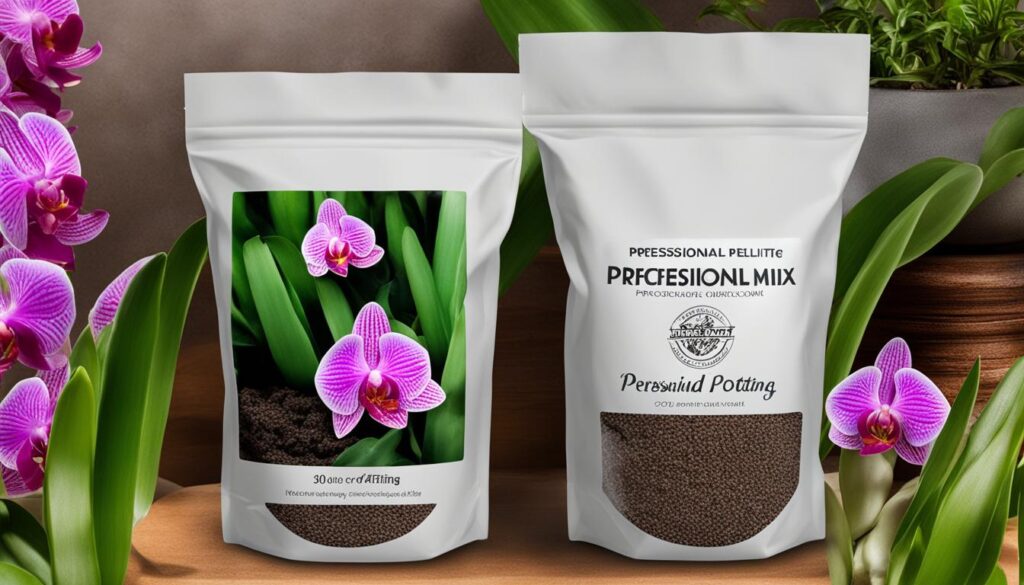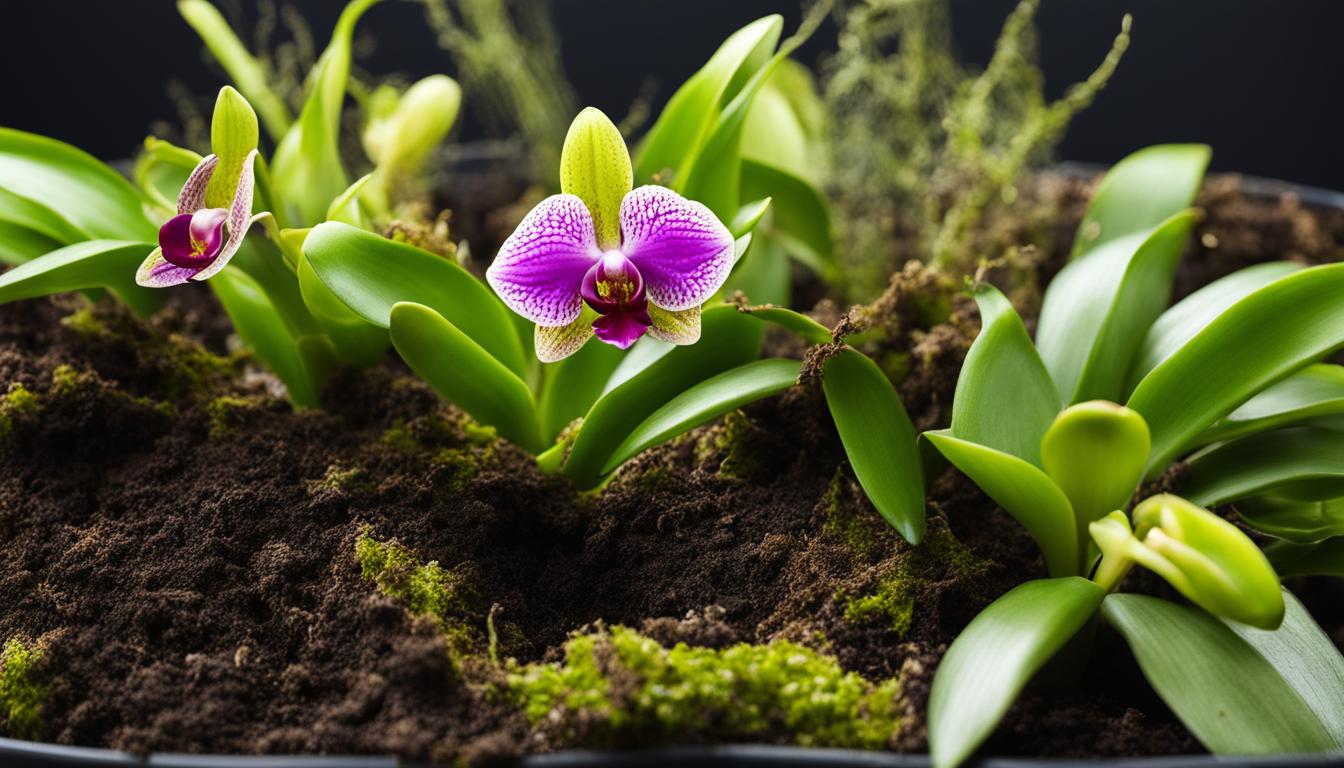As an orchid enthusiast, I’ve learned that finding the ideal soil for orchids isn’t just about planting and waiting for blooms; it’s about understanding and catering to the nuanced needs of these exquisite plants.
Specialized orchid soil and potting mixes are essential for their prosperity, providing the right balance of drainage, aeration, and nutrients.
I’ve experimented with various combinations and discovered that the best orchid soil tends to include a blend of fir or pine bark, coarse sand or perlite, and sphagnum moss.
These ingredients work collectively to mimic the natural conditions orchids love, ensuring that your prized plants have the perfect home to thrive and flourish.
For those seeking a professional-grade option without the hassle of homemade mixes, a premium potting mix for orchids is the go-to choice for vibrant health and stunning blooms.
Key Takeaways
- Choosing the correct potting mix is crucial for orchid health and bloom quality.
- The best mixes replicate orchids’ natural growing conditions with breathable, well-draining components.
- Ingredients like fir bark, charcoal, and sphagnum moss are key for a healthy orchid substrate.
- A premium potting mix for orchids often yields the most rewarding growth and flowering results.
- While mixing your own soil can be gratifying, ready-made high-quality mixes are available for convenience.
Understanding the Essentials of Orchid Soil and Potting Mixes
As an orchid enthusiast, I’ve learned that these exotic plants flourish in an environment that mimics their natural habitat, which is often high above the ground in the branches of trees.
This epiphytic lifestyle calls for a recommended potting mix for orchids that provides not just nutrients and support but also the right balance of drainage and aeration.
Through my experiences and research, I’ve discovered the importance of using organic orchid soil, a component that replicates the kind of forest detritus orchids would naturally grow in.
These soils are particularly tailored to encourage healthy root systems, which are essential for the vitality and longevity of the plants.
When crafting a high-quality orchid planting medium, it is imperative to include ingredients that improve drainage, allowing excess water to escape, thus protecting the delicate roots from rot.
However, these components should also be capable of retaining some moisture to prevent the orchids from drying out completely. In my search for the best medium, I’ve come across various organic materials such as chunky pine bark, charcoal, and perlite, which all play a role in the creation of an ideal growing condition for these stunning plants.
- Pine Bark: Assists in drainage and simulates the orchid’s natural environment.
- Charcoal: Filters impurities and retains essential nutrients.
- Perlite: Enhances soil structure, promoting both moisture retention and proper drainage.
An exceptional orchid potting mix also involves a balancing act with nutrients. It is not enough to simply water these tropical beauties; I must ensure that the soil can support the addition of specialized orchid fertilizers, designed to supply the specific nutrients they require.
These fertilizers are especially crucial during the growth and blooming periods when orchids are most hungry for extra sustenance.
Ensuring the health of my orchids ultimately comes down to the careful selection of a recommended potting mix for orchids.
It took time and patience to understand the unique needs of my orchid collection, but the reward of vibrant blooms and robust growth has been well worth the effort.
Every orchid variety may have its specific requirements, but starting with the right foundation of organic soil and potting mix is a sure step towards a thriving orchid display.
Orchid Soil and Potting Mixes: Drainage, Aeration, and Moisture Balance
As a dedicated orchid enthusiast, I understand the critical role that soil composition plays in the health and beauty of these magnificent plants.
It’s not just about providing them with water and light; the very medium in which they grow dictates their ability to thrive.
Let’s delve into the essentials of creating the ideal soil environment for orchids, one that ensures the right balance of drainage, aeration, and moisture.
Perfecting Drainage to Prevent Root Rot
One of the paramount concerns in orchid care is avoiding the dreaded root rot. Overly moist conditions can be perilous, so selecting or making an orchid soil with perlite is a prudent choice.
Perlite, revered for its ability to improve drainage and reduce water retention, helps to create a soil environment that’s inhospitable to the fungi that cause root decay.
Aerating the Medium for Optimal Root Health
Proper aeration is also crucial. An orchid’s roots are not just anchor points; they’re lifelines that absorb air as well as water.
By incorporating items like charcoal and fir bark, a top-rated orchid potting mix can provide ample oxygen flow.
These components prevent compaction and keep the roots from suffocating, ensuring that your orchids can breathe easy and stay healthy.
Balancing Moisture for Lush Orchid Growth
Last but certainly not least is the delicate balance of moisture. While orchids relish humidity, they abhor fogginess.
Incorporating organic materials such as sphagnum moss and coconut fiber into your premium potting mix for orchids will help retain the right amount of water.
These elements work in harmony, creating a cozy yet breathable home for your orchid, where it’s moist enough to drink but dry enough to deter rot.

In summary, whether you opt for a ready-made professional orchid potting mix or concoct your very own blend, remember the critical importance of avoiding waterlogged conditions.
By emphasizing proper drainage, ensuring ample air circulation, and maintaining a steady but not excessive moisture presence, you’ll foster the ideal soil for orchids – a foundation where these exotic beauties can not only survive but spectacularly flourish.
Organic Ingredients: Building Blocks of High-Quality Orchid Planting Medium
As I delve into the art of orchid care, I’ve discovered that organic orchid soil is not just a trend; it’s a fundamental aspect of nurturing these exotic plants.
The best orchid soil I’ve come across features a symphony of natural elements, each playing a vital role in simulating an orchid’s indigenous, airy habitat.

Imagine each ingredient in a high-quality orchid planting medium as a building block, creating a micro-ecosystem where orchids can flourish.
For example, tree fern fiber and coco husk chips contribute to both the soil’s structural integrity and its moisture retention capabilities.
Sphagnum moss, a component I hold in high regard, serves a dual purpose: it expertly retains water while also providing exceptional aeration, a balance that is crucial for the prevention of fungal growth and root rot.
Fir bark, in particular, has won my endorsement. Its rugged texture promotes excellent airflow and it resists water initially (though it does so without completely shunning moisture) granting the roots the ‘breathing room’ they require.
As it decomposes at a measured pace, fir bark ensures longevity in the medium’s performance, reducing the frequency of repotting.
- Tree Fern Fiber – Enhances structural support
- Coco Husk Chips – Offers excellent moisture retention
- Sphagnum Moss – Balances aeration with hydration
- Quality Fir Bark – Provides a lasting, breathable environment for roots
I look upon these ingredients with a sense of reverence, for they are more than mere substrates. They encapsulate the essence of a natural, beneficial environment, making a world of difference in my orchid cultivation endeavors. Choosing the right organic ingredients is not just a step in orchid care, it’s a leap towards fostering vibrancy and vitality in these captivating plants.
Orchid Soil With Perlite: Why It’s a Game-Changer for Your Plants
I’ve found that incorporating orchid soil with perlite into my planting practice has transformed how I approach orchid care.
Perlite, a volcanic glass with high water content, is processed and expanded to create a lightweight aerated medium that maintains ample aeration and moisture for fine-rooted plants like orchids.
By utilizing a professional orchid potting mix that includes perlite, I ensure my orchids are provided with the ideal conditions to thrive.
Perlite’s airy structure is the key to its effectiveness – it prevents soil compaction which is essential for delicate orchid roots that require consistent access to both water and air for optimum health.
Additionally, it aids in evenly distributing moisture throughout the potting mix, which is paramount in simulating the natural epiphytic environment in which many orchid species typically grow.
- Improves drainage, preventing waterlogging and root rot
- Enhances aeration, allowing roots to breathe and thrive
- Retains necessary nutrients in the potting mix
- Helps regulate moisture levels, reducing the risk of overwatering
In aligning with the needs of orchid enthusiasts for a superior mix, I’ve put together a comparison table showcasing the common potting materials against perlite-infused mixes:
| Potting Material | Drainage Quality | Aeration Levels | Moisture Retention |
|---|---|---|---|
| Traditional Bark Mix | Good | Moderate | Low |
| Sphagnum Moss | Poor | Low | High |
| Coarse Sand Mix | Excellent | Low | Low |
| Orchid Soil with Perlite | Excellent | High | Moderate |

The comparison makes it evident that a professional orchid potting mix with perlite strikes an ideal balance among all necessary parameters, and this is why I’m a strong proponent of its use.
Whether you’re a seasoned orchid grower or just starting out, leveraging the benefits of perlite can make a significant difference in the health and vibrancy of your orchid collection.
Top-Rated Orchid Potting Mix Choices for Thriving Blooms
As an orchid enthusiast, I’m always on the lookout for ways to help my blooms reach their full potential. The secret lies in the potting mix, and I’ve learned that not all mixes are created equal.
Finding the top-rated orchid potting mix can be a game-changer for the health and vibrancy of your plants. A good mix should contain essential ingredients that facilitate drainage, aeration, and nutrient uptake.
Let me share my insights on the ideal components and how you can personalize the mix to suit different orchid species.

Decoding the Ingredients: What to Look For
Choosing a recommended potting mix for orchids often begins with a look at the ingredients list. The best orchid soil should include a harmonious blend that ensures your plants have the environment they need. Here’s what to keep an eye on:
- Fir Bark: For that crucial airflow around the roots.
- Charcoal: Acts as a natural filter to maintain soil purity.
- Coarse Perlite: Facilitates water drainage and air penetration.
- Lava Rock: Prevents compaction, allowing roots to breathe and flourish.
These ingredients play a pivotal role in creating the premium potting mix for orchids that supports robust growth and heralds a profusion of blooms.
Personalizing Your Mix: Potting Mixes for Diverse Orchid Varieties
Different orchid varieties can often require specific conditions tailored to their native habitats. For instance:
| Orchid Variety | Potting Mix Characteristics | Benefits |
|---|---|---|
| Slipper Orchids, Oncidiums, and Miltonias | Finer Mix, High Moisture Retention | Supports delicate root systems and maintains a stable moisture environment. |
| Moth Orchids, Cattleyas, and Mature Orchids | Medium Mix, Balanced Drainage and Aeration | Promotes healthy root growth and mitigates the risk of waterlogging. |
By understanding these needs and customizing your approach, you can ensure that your orchids receive the best care possible. It’s about finding that sweet spot – a top-rated orchid potting mix that combines the best ingredients with the right texture and moisture-retaining properties.
When you achieve this, you’re not just potting plants; you’re cultivating a beautiful orchid showcase that is a testament to your care and dedication.
Conclusion
As we reach the final note in our botanical journey, I’m reminded of the essential truths that underpin our orchid care.
The selection of a premium potting mix for orchids is not merely a choice but a commitment to the health and vibrancy of these exotic beauties.
With ingredients like fir bark and perlite, we create a sanctuary for roots to thrive, balancing the trifecta of moisture, nutrients, and aeration with precision.
My experiences have taught me the value of organic orchid soil, not just in its ability to foster growth but also in contributing to a more natural orchid living environment.
Whether I’m concocting my blend or choosing a high-quality orchid planting medium from the market, the objective remains steadfast – to provide the best possible habitat for my orchid’s prosperity.
Embracing the art and science of orchid planting mediums has transformed my approach to orchid cultivation.
The payoff, radiant blooms, and robust health is a testament to the meticulous care and attention to detail required in selecting the right soil and potting mix.
In entrusting these fundamental principles, my orchids do more than just survive; they flourish, sharing their unparalleled splendor in a celebration of life and natural beauty.
FAQ
What are the essential components of a good orchid soil and potting mix?
The essential components of a good orchid soil and potting mix include fir or pine bark for drainage, perlite or coarse sand for aeration, charcoal to filter impurities, and sphagnum moss to retain just the right amount of moisture. The combination of these ingredients ensures a well-draining, airy, and nutrient-supportive environment for orchids.
Why is an organic orchid soil recommended?
Organic orchid soil is recommended because it usually contains natural, eco-friendly ingredients that mimic the orchid’s native growing conditions. Organic materials such as sphagnum moss, coconut fiber, and fir bark provide essential nutrients, enhance moisture retention while preventing waterlogging, and support healthy root growth.
How does perlite improve orchid soil?
Perlite improves orchid soil by enhancing its drainage and aeration capabilities, which are crucial for preventing root rot in orchids. This porous material also helps to retain nutrients and moisture, ensuring that the roots have constant access to what they need for growth while also preventing soil compaction.
What’s the importance of drainage in an orchid potting mix?
Drainage is of paramount importance in an orchid potting mix because orchids are susceptible to root rot if water accumulates around their roots. A well-draining mix allows water to flow through quickly, preventing excess moisture from harming the orchid’s delicate root system.
What should I look for in a top-rated orchid potting mix?
In a top-rated orchid potting mix, look for ingredients that promote airflow such as fir bark, ingredients for moisture and nutrient retention like sphagnum moss, and a component for preventing soil compaction, like perlite. Additionally, charcoal is a good addition for filtering impurities and keeping the mix clean.
Can I use regular potting soil for my orchids?
It is not recommended to use regular potting soil for orchids because it typically doesn’t provide the necessary aeration, drainage, and texture that orchids require. Regular potting soil can retain too much moisture and become compacted, which can suffocate orchid roots and lead to disease.
How often should I repot my orchids, and do I need to change the orchid soil?
Orchids typically need repotting every 1-2 years, or when you notice the potting medium breaking down, which could cause insufficient drainage and aeration. When repotting, it’s important to refresh the orchid soil to replenish its structure and nutrient content, and to inspect the roots for any signs of decay or disease.
Are there different potting mixes for different types of orchids?
Yes, different types of orchids may have specific needs, and as such, may thrive best in different potting mixes. Fine potting mixes with higher moisture retention are typically better for delicate orchids like slipper orchids, while coarser mixes are ideal for moth orchids and other species that prefer drier conditions with excellent drainage and airflow.


Leave a Reply